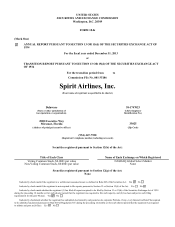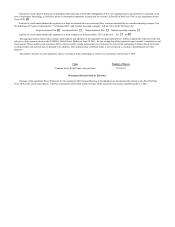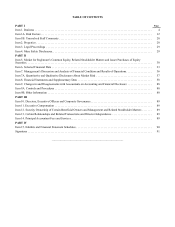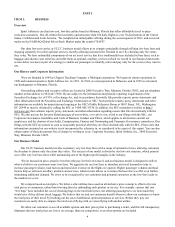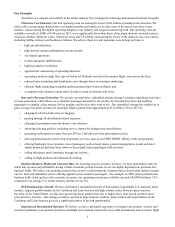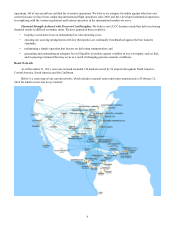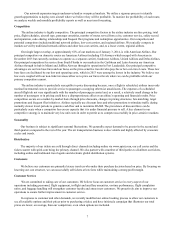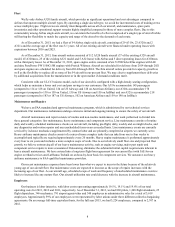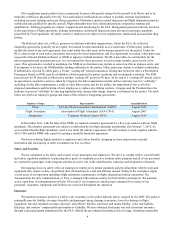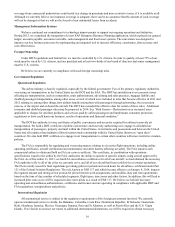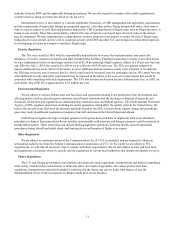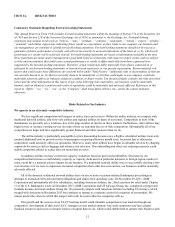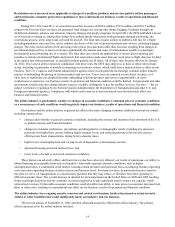Spirit Airlines 2013 Annual Report Download - page 5
Download and view the complete annual report
Please find page 5 of the 2013 Spirit Airlines annual report below. You can navigate through the pages in the report by either clicking on the pages listed below, or by using the keyword search tool below to find specific information within the annual report.5
Our Strengths
We believe we compete successfully in the airline industry by leveraging the following demonstrated business strengths:
Ultra-Low Cost Structure. Our unit operating costs are among the lowest of all airlines operating in the Americas. We
believe this cost advantage helps protect our market position and enables us to offer some of the lowest base fares in our
markets, sustain among the highest operating margins in our industry and support continued growth. Our operating costs per
available seat mile (CASM) of 9.90 cents in 2013, were significantly lower than those of the major domestic network carriers,
American Airlines, Delta Air Lines, United Air Lines and US Airways and among the lowest of the domestic low-cost carriers,
including JetBlue Airways and Southwest Airlines. We achieve these low unit operating costs in large part due to:
• high aircraft utilization;
• high-density seating configurations on our aircraft;
• our simple operations;
• no hub-and-spoke inefficiencies;
• highly productive workforce;
• opportunistic outsourcing of operating functions;
• operating a modern single fleet type of Airbus A320-family aircraft with common flight crews across the fleet;
• reduced sales, marketing and distribution costs through direct-to-consumer marketing;
• efficient flight scheduling, including minimal ground times between flights; and
• a company-wide business culture that is keenly focused on driving costs lower.
Innovative Revenue Generation. We execute our innovative, unbundled pricing strategy to produce significant non-ticket
revenue generation, which allows us to stimulate passenger demand for our product by lowering base fares and enabling
passengers to identify, select and pay for the products and services they want to use. Our unbundled strategy has enabled us to
grow average non-ticket revenue per passenger flight segment from approximately $5 in 2006 to $54 in 2013 by:
• charging for checked and carry-on baggage;
• passing through all distribution-related expenses;
• charging for premium seats and advance seat selection;
• enforcing ticketing policies, including service charges for changes and cancellations;
• generating subscription revenue from our $9 Fare Club ultra low-fare subscription service;
• deriving brand-based revenues from proprietary services, such as our FREE SPIRIT affinity credit card program;
• offering third-party travel products (travel packages), such as hotel rooms, ground transportation (rental and hotel
shuttle products) and attractions (show or theme park tickets) packaged with air travel;
• selling third-party travel insurance through our website;
• selling in-flight products and onboard advertising.
Resilient Business Model and Customer Base. By focusing on price-sensitive travelers, we have maintained relatively
stable unit revenue and profitability during volatile economic periods because we are not highly dependent on premium-fare
business traffic. We believe our growing customer base is more resilient than the customer bases of most other airlines because
our low fares and unbundled service offering appeal to price-sensitive passengers. For example, in 2009, when premium-fare
business traffic dried up due to the economic recession, our operating revenue per available seat mile (RASM) declined 1.9%,
compared to an average U.S. airline industry decline of over 9%.
Well Positioned for Growth. We have developed a substantial network of destinations in profitable U.S. domestic niche
markets, targeted growth markets in the Caribbean and Latin America and high-volume routes flown by price-sensitive
travelers. In the United States, we also have grown into large markets that, due to higher fares, have priced out those more
price-sensitive travelers. Our strategy to balance growth in large domestic markets, niche markets and opportunities in the
Caribbean and Latin America gives us a significant number of growth opportunities.
Experienced International Operator. We believe we have substantial experience in foreign local aviation, security and
customs regulations, local ground operations and flight crew training required for successful international and overwater flight

